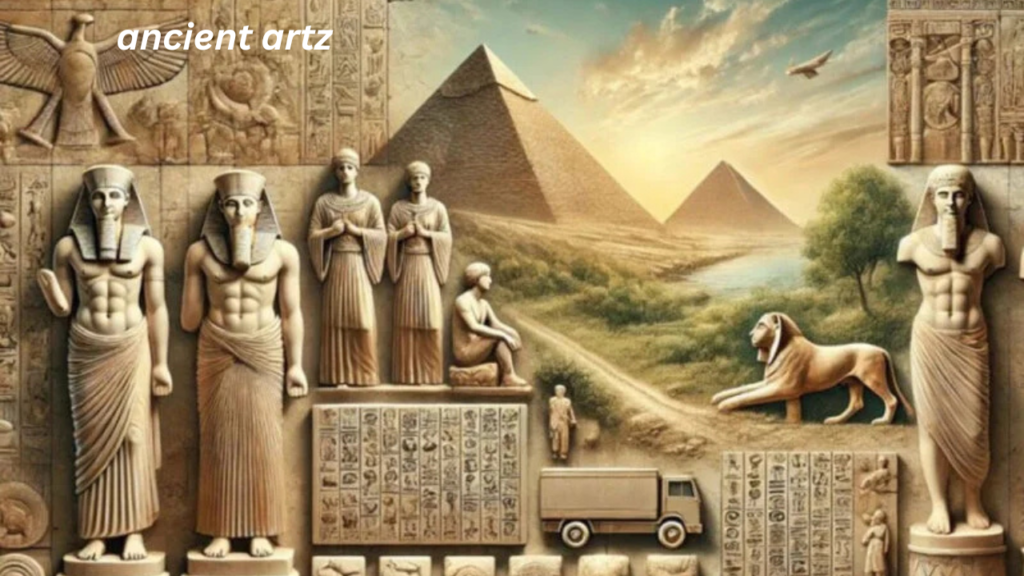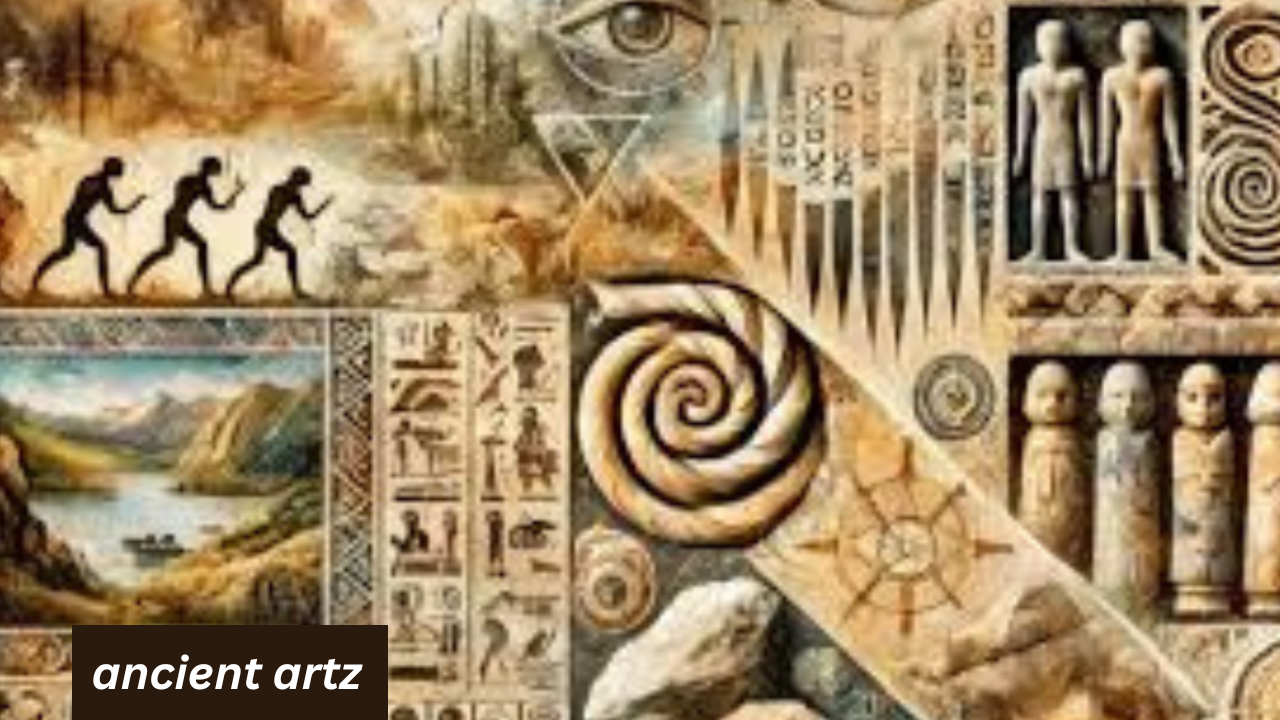Throughout history, art has been a powerful tool for humans to express their culture, beliefs, and values. The earliest artistic movements, often referred to as “ancient artz,” offer valuable insights into the origins of human creativity and civilization. These ancient works of art were not merely aesthetic; they carried profound meaning, symbolism, and even spiritual significance. In this article, we explore the legacy of ancient artz, uncovering the mysteries behind early artistic movements, and examining their lasting impact on the world today.
The Origins of Ancient Artz

Ancient artz refers to the visual arts produced by early human societies, typically before the advent of written language. This includes paintings, sculptures, pottery, carvings, textiles, and other forms of artistic expression. The earliest forms of art can be traced back over 40,000 years to the Paleolithic period, when humans first began creating symbolic representations on cave walls. These early works of art were likely made for a variety of purposes, including storytelling, ritualistic practices, and communication.
The most famous examples of ancient artz come from cave paintings in places like Lascaux in France, Altamira in Spain, and Chauvet Cave. These paintings, often depicting animals and human figures, were created using natural pigments such as ochre, charcoal, and other earth-based materials. These ancient artworks not only demonstrate early humans’ ability to manipulate materials but also reveal their deep connection to nature and their environment.
The Significance of Symbolism in Ancient Artz
Symbolism played a crucial role in ancient artz. Early humans did not just create art for decoration—they used it as a means of communicating ideas, beliefs, and experiences. Many of the symbols found in ancient artwork carry spiritual or religious significance, representing the relationship between humans, gods, and the natural world.
In ancient Egyptian art, for example, every aspect of a painting or sculpture had a symbolic meaning. Gods and pharaohs were often depicted with specific attributes, such as the crook and flail of a pharaoh, symbolizing rulership and protection. The use of color was also deeply symbolic; for instance, green was associated with fertility, rebirth, and the Nile, while gold represented the divine.
Similarly, the art of ancient Mesopotamia often depicted gods, kings, and mythical creatures. The famous “Standard of Ur,” an artifact discovered in the Royal Cemetery at Ur, depicts a series of scenes with symbolic imagery. The artwork portrays the contrast between war and peace, illustrating the power dynamics of the time. Through these depictions, ancient societies communicated their values, social hierarchies, and religious beliefs.
Early Artistic Movements Across Different Cultures
While ancient artz shares some universal themes, such as symbolism and connection to the divine, each culture developed its own distinct artistic styles and techniques. Let’s explore some of the most prominent early artistic movements across various civilizations.
Ancient Egyptian Art
The art of ancient Egypt is perhaps one of the most recognizable forms of ancient artz. Egyptian art was highly stylized and followed strict conventions. It was meant to honor the gods and pharaohs, as well as to ensure an individual’s successful journey into the afterlife. Egyptian art was characterized by its use of hieratic scale, where figures of importance, such as pharaohs or gods, were depicted larger than others. This helped to emphasize their power and divinity.
Egyptian paintings, sculptures, and reliefs adhered to strict rules about proportion and perspective. Figures were often shown in composite view, with heads and legs in profile but torsos facing forward, creating a symbolic sense of clarity and order. Many of these artworks were created for tombs and temples, designed to aid in the journey to the afterlife.
Ancient Greek and Roman Art
The ancient Greeks and Romans built upon earlier traditions of art, incorporating more realistic depictions of the human form. Greek art, particularly during the Classical period (5th to 4th centuries BCE), emphasized harmony, balance, and idealized beauty. Sculptors such as Phidias and Praxiteles created lifelike statues of gods, athletes, and citizens, showcasing a deep understanding of anatomy and proportion.
Roman art, influenced by Greek styles, was more focused on realism and the depiction of everyday life. Roman portraits, for instance, were known for their extreme detail, with wrinkles, scars, and other imperfections emphasized to portray the subject’s age and wisdom. Roman art often celebrated the achievements of emperors and military leaders, with monumental sculptures like the Trajan’s Column and the Arch of Titus serving as lasting records of military victories.
Ancient Chinese Art
Chinese art has a rich history that spans thousands of years, with early artistic movements being influenced by both spiritual and philosophical ideas. Ancient Chinese art often focused on nature, with landscape painting being a dominant theme. The concept of “Qi,” or life force, played a significant role in Chinese art, with artists striving to capture the essence of nature rather than a realistic representation.
Ancient Chinese art also includes pottery, jade carvings, and bronze sculptures, all of which were used for ritualistic and ceremonial purposes. The famous Terracotta Army, discovered in the tomb of China’s first emperor, Qin Shi Huang, is one of the most remarkable examples of ancient Chinese art. The lifelike figures, each with unique facial expressions, were created to protect the emperor in the afterlife.
Ancient Mesoamerican Art
The art of ancient Mesoamerican cultures, such as the Maya, Aztec, and Olmec, was deeply tied to their religious and cosmological beliefs. Mesoamerican art often depicted gods, animals, and celestial events. Sculptures, carvings, and murals were used to convey complex religious stories and rituals.
One of the most famous examples of Mesoamerican art is the calendar stone, or the Aztec Sun Stone, which symbolizes the cycles of time and the movement of the sun. The Maya also created intricate stone carvings and murals, many of which depicted their rulers and important events.
The Legacy of Ancient Artz in the Modern World
The legacy of ancient artz is still visible in today’s world. The influence of early artistic movements can be seen in modern art, architecture, and even fashion. The exploration of human form, the use of symbolism, and the pursuit of beauty are themes that continue to resonate with artists today.
In addition, many ancient artworks have been preserved and studied by archaeologists, art historians, and museum curators. These works of art provide a direct link to our ancestors, allowing us to gain a deeper understanding of their lives, beliefs, and cultures. Today, many ancient artworks are displayed in museums and galleries around the world, where they continue to inspire and educate.
Modern artists have drawn inspiration from ancient artz, incorporating elements of classical Greek and Roman sculpture, Egyptian symbolism, and Chinese philosophy into their own works. The abstract art movement of the 20th century, for example, shares a common thread with ancient cave paintings, where form and color were used to express emotional and spiritual truths.
Conclusion
The legacy of ancient artz offers a profound and enduring connection to our past. From the symbolic cave paintings of the Paleolithic era to the detailed sculptures of ancient civilizations, art has always been a means of expressing human experiences, beliefs, and emotions. The mysteries of early artistic movements continue to fascinate and inspire us, providing a glimpse into the lives of our ancestors and the creativity that shaped their worlds. As we look to the future, the impact of ancient artz remains an essential part of our cultural heritage, reminding us of the timeless power of human expression.
FAQs
What is ancient artz?
Ancient artz refers to the artistic expressions of early human societies before the development of written language. This includes cave paintings, sculptures, pottery, and other forms of art created for spiritual, ritualistic, or cultural purposes.
What role did symbolism play in ancient artz?
Symbolism was a key element in ancient artz. It allowed early civilizations to communicate ideas, beliefs, and values. Symbols were often used to represent gods, celestial events, and important cultural concepts.
How did ancient Egyptian art differ from ancient Greek art?
Ancient Egyptian art was highly stylized, focusing on divine figures and rulers with strict conventions. In contrast, Greek art emphasized idealized human forms and balanced proportions, with a focus on beauty and realism.
How did Mesoamerican art reflect religious beliefs?
Mesoamerican art often depicted gods, celestial events, and the natural world. It was deeply tied to religious and cosmological beliefs, with works used to communicate stories of creation, rituals, and divine power.
What is the significance of ancient artz in modern times?
The legacy of ancient artz continues to influence modern art and culture. Ancient artworks provide valuable insights into human history, spirituality, and creativity, inspiring contemporary artists and shaping cultural practices worldwide.
You May Also Read: https://usdigitaltime.com/aviva-taeidkashani/
